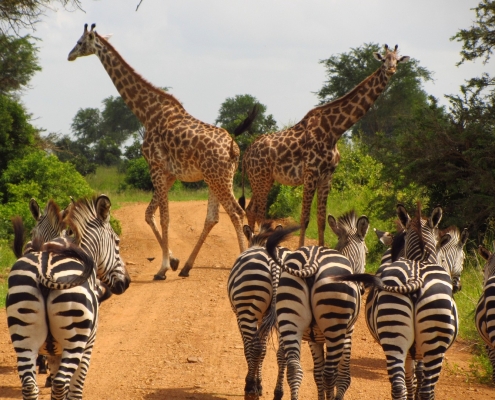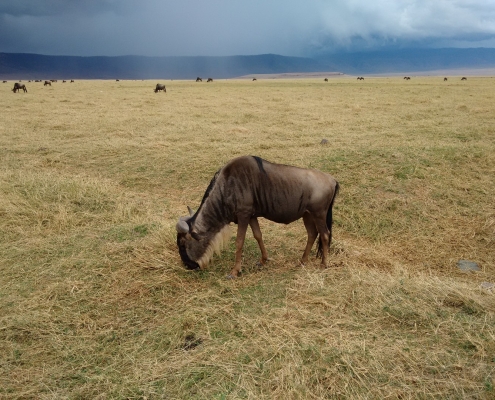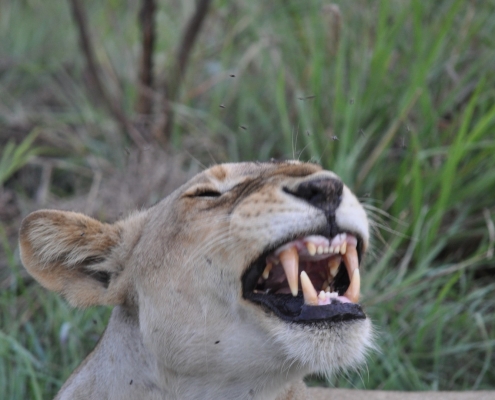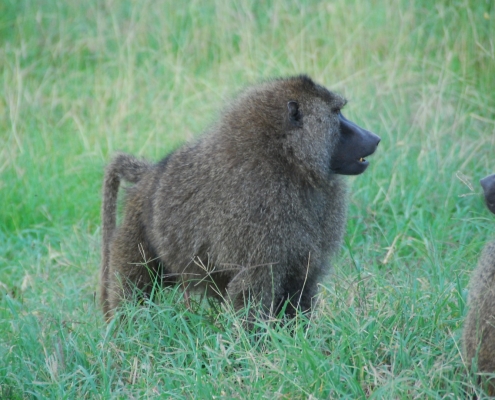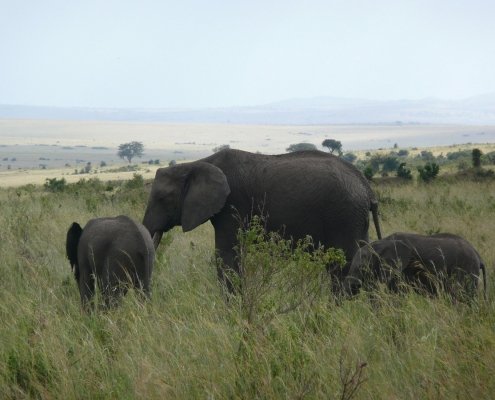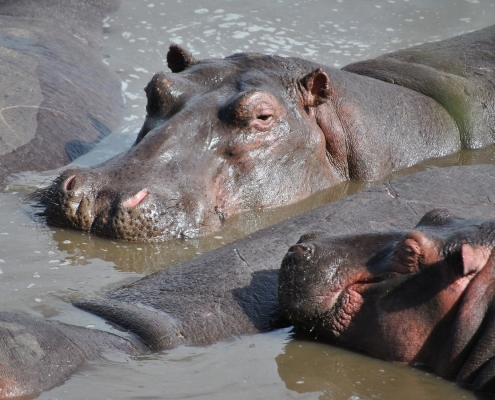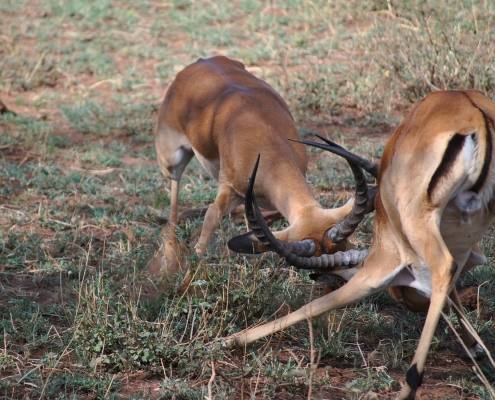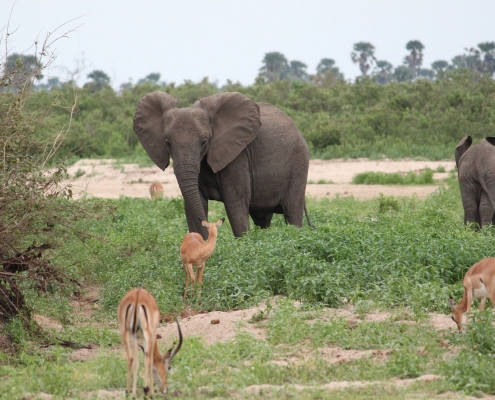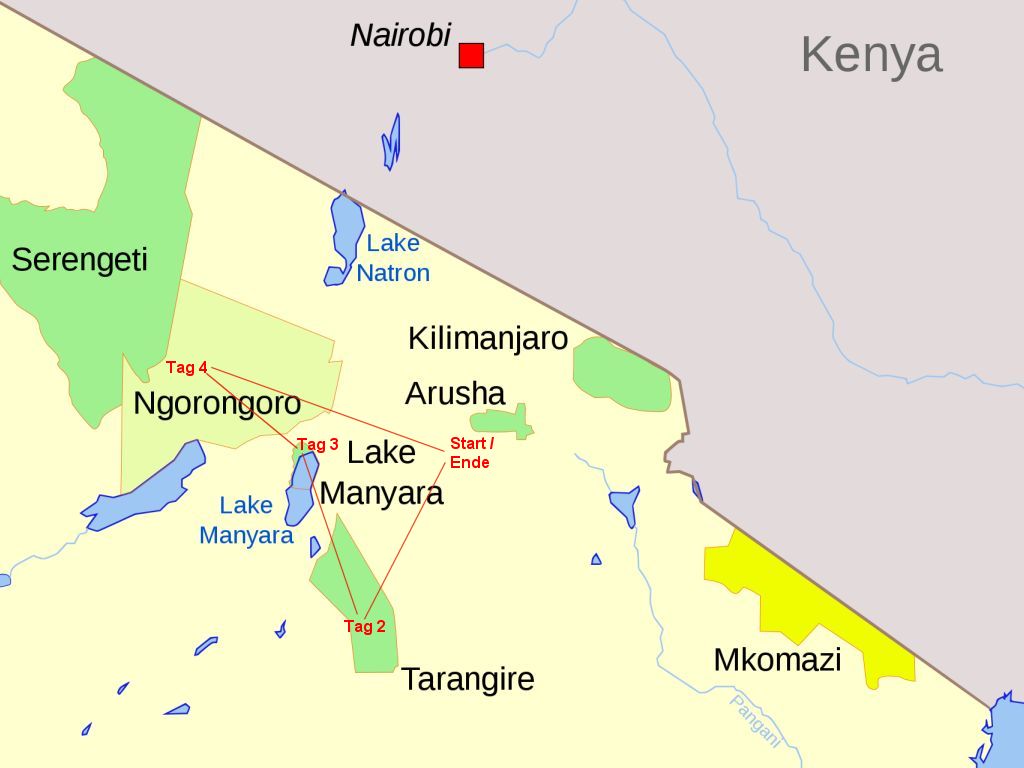5 Days Tanzania Safari Express
brief overview
This short safari offers a 5 days (4 nights) tour in a 4×4 vehicle to three famous and very diverse national parks in Northern Tanzania. On this Safari you will visit the Ngorongoro Conservation Area, with its world famous caldera filled with large mammals all year round, Lake Manyara National Park with its different landscape zones and Tarangire National Park, famous for its large elephant herds and the ancient Baobab trees.
The tour is suitable for travellers who have little time but do not want to miss out on visiting three of the famous parks in the north of the country. Despite the short time frame, this safari is a great adventure as you can experience three very different landscapes and habitats in beautiful Tanzania.
Day 1: Arrival in Arusha
Transfer from Kilimanjaro Airport or Arusha Bus Station (e.g. via Nairobi) to your accommodation.
Day 2: Arusha – Tarangire National Park
You leave Arusha after breakfast and drive about 1-2 hours to Tarangire National Park, 80 km away. On the way you will pass lively Masai villages and the wide plains for which East Africa is so famous. The Tarangire National Park is very large, all in all 2600 square kilometers, about the size of U.S. State Rhode Island. There are extensive, including two large pans in the south that turn into swamps depending on the season. After Serengeti, Ruaha and Mikumi, the Tarangire is the fourth largest park in Tanzania. It is named after the Tarangire River, which rises in the mountains south of the park. This river winds its way from the extreme south through numerous rocky hilly landscapes, which are between 1000 and 1675 meters high, almost to the northernmost tip of the game reserve. Here it turns westwards in a swerve and flows into Lake Burungi, which has no outflow and is located in the north-east of the park. There is water in the river all year round, very important for the local flora and fauna.
Once you reach Tarangire Park, you will begin your game drive through a hilly grass savannah landscape dominated by the imposing baobab trees (Adansonia digitata), which grow in abundance here. They are also known as Baobab trees. A picnic area overlooking the Tarangire River is a nice option for a lunch break with views. As you drive through the park you will also have the opportunity to see elephants, lions, leopards, buffalo and a variety of antelopes. If you are lucky you may even see endangered animals such as the African wild dog. In the late afternoon or evening you will drive to your chosen accommodation.
Day 3: Tarangire National Park – Lake Manyara National Park
Today we travel to Lake Manyara National Park; the protected area lies picturesquely as a narrow strip of shore between the western slope of the approximately 800-metre-high rift valley steep face and the soda-rich Lake Manyara. Although the park is not particularly large, it is, so to speak, a masterpiece in terms of its different habitats: the rocky Rift Valley escarpment, the groundwater forest, the acacia tree savannah, the open grass savannah, the lake shore, the numerous swamps and the lake itself. Lake Manyara National Park is one of the greenest and most exotic game reserves in the country. The biomass of animals that inhabit the park is enormous: the grass savannah is home to wildebeest, zebra, waterbuck, reedbuck, impala and Thomson’s gazelles. In the acacia groves bushbucks with their ivory-coloured spiral horns together with the small dikdiks stalk gracefully over the water-soaked ground. In the bush land you can find the massive and unpredictable buffalos again. The vegetation along the rivers is often a gallery forest, where dump palms and wild date palms grow. The trees provide the wild animals with plenty of shade and food. The tree-climbing lions are a well-known landmark of the park, these powerful predators pose on acacia trees and want to be photographed. Ornithologists will love Lake Manyara with its great variety of birds.
If you wish, you can visit the nearby market town of Mto Wa Mbu. This place with its agricultural and fresh products is a melting pot of local cultures and a paradise for souvenir hunters. The landscape of the area is green like an oasis. This change in the vegetation is due to the fact that the two rivers Kirurumu and Simba, which come from the Ngorongoro Highlands through porous lava rock layers underground, pour their water masses here at Mto wa Mbu into this otherwise barren rift valley zone. This is transformed into a particularly fertile area. There is plenty of cultivated land here, where a lot of vegetables and fruit are grown. In this market town there is a colourful life and bustle. It also features many “Dukas” here. These are shops where you can find everything from ebony carvings to colourful cloths. A speciality that should not be missed are the red bananas. You will certainly notice them immediately when you look at the fruit stands. They are shorter and thicker than conventional bananas, and they also have a fruitier taste. After the thrill and the many impressions of the day, you return to your accommodation for a well-deserved dinner.
Day 4: Manyara National Park – Ngorongoro Conservation Area
After an early morning refreshment you will drive to the Ngorongoro Conservation Area, also known as the 8th wonder of the world. The tarred road takes you higher and higher up to the Ngorongoro crater rim. The road climbs steeply in serpentines through a noticeably cool, fairytale mountain forest on the outer slopes of the crater. After a few kilometres you will reach the Loduare Park gate, the entrance to the Conservation Area. After completing the entrance formalities, the journey continues uphill through ever denser jungle with bearded lichens and ferns. The tension rises, as it is not far to the edge of the world-famous Ngorongoro Crater. After a short ride the highest point and the first viewpoint is reached at a height of 2286 meters. From the edge of the crater to the crater floor it is about 650 meters altitude. If you look down, you can see savannah areas, swamps, rivers, forests, small hills and the soda lake, which is called Lake Magadi here. With the help of binoculars you can see herds of buffalo, wildebeest, zebra and gazelles walking on the crater floor. Afterwards you will descend into the crater and start a spectacular game drive in the crater floor.
The Ngorongoro Conservation Area is home to over 120 species of mammals, including the legendary Big Five. The crater area is home to around 20,000 large mammals – buffalo, zebra, antelope, elephant… There are over 100 lions and more than 400 spotted hyenas. It is one of the most popular safari destinations in the world and one of the few places in the world where the black rhino can be seen. The Ngorongoro Crater is not a crater in the true sense of the word. Geomorphologically it is a caldera, which means that after its last eruption its crater cone collapsed in the middle after the lava flowed out and formed this enormous crater bowl. It is the sixth largest caldera on the mainland of the earth. Afterwards you will return to Arusha to your chosen accommodation for dinner.
Day 5: Arusha Safari End
After breakfast transfer to the central bus station, to the airline office in the city for your shuttle bus to the airport or extension e.g. onward flight to Zanzibar, day trip.
Itinerary
Day 1: Arrival in Arusha
Day 2: Tarangire National Park
Day 3: Manyara National Park
Day 4: Ngorongoro Conservation Area
Day 5: End of Safari, Arusha


